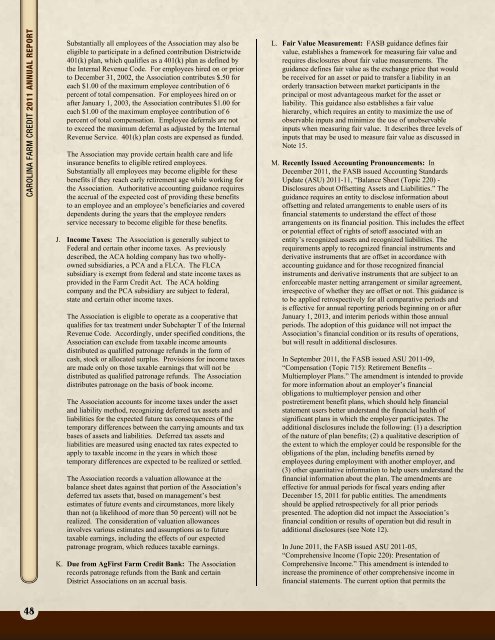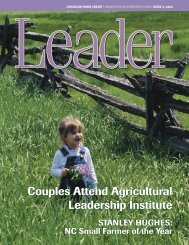2011 Annual Report - Carolina Farm Credit
2011 Annual Report - Carolina Farm Credit
2011 Annual Report - Carolina Farm Credit
You also want an ePaper? Increase the reach of your titles
YUMPU automatically turns print PDFs into web optimized ePapers that Google loves.
<strong>Carolina</strong> <strong>Farm</strong> <strong>Credit</strong>, ACA<br />
<strong>Carolina</strong> <strong>Farm</strong> <strong>Credit</strong> <strong>2011</strong> <strong>Annual</strong> <strong>Report</strong><br />
Substantially all employees of the Association may also be<br />
eligible to participate in a defined contribution Districtwide<br />
401(k) plan, which qualifies as a 401(k) plan as defined by<br />
the Internal Revenue Code. For employees hired on or prior<br />
to December 31, 2002, the Association contributes $.50 for<br />
each $1.00 of the maximum employee contribution of 6<br />
percent of total compensation. For employees hired on or<br />
after January 1, 2003, the Association contributes $1.00 for<br />
each $1.00 of the maximum employee contribution of 6<br />
percent of total compensation. Employee deferrals are not<br />
to exceed the maximum deferral as adjusted by the Internal<br />
Revenue Service. 401(k) plan costs are expensed as funded.<br />
The Association may provide certain health care and life<br />
insurance benefits to eligible retired employees.<br />
Substantially all employees may become eligible for these<br />
benefits if they reach early retirement age while working for<br />
the Association. Authoritative accounting guidance requires<br />
the accrual of the expected cost of providing these benefits<br />
to an employee and an employee’s beneficiaries and covered<br />
dependents during the years that the employee renders<br />
service necessary to become eligible for these benefits.<br />
J. Income Taxes: The Association is generally subject to<br />
Federal and certain other income taxes. As previously<br />
described, the ACA holding company has two whollyowned<br />
subsidiaries, a PCA and a FLCA. The FLCA<br />
subsidiary is exempt from federal and state income taxes as<br />
provided in the <strong>Farm</strong> <strong>Credit</strong> Act. The ACA holding<br />
company and the PCA subsidiary are subject to federal,<br />
state and certain other income taxes.<br />
The Association is eligible to operate as a cooperative that<br />
qualifies for tax treatment under Subchapter T of the Internal<br />
Revenue Code. Accordingly, under specified conditions, the<br />
Association can exclude from taxable income amounts<br />
distributed as qualified patronage refunds in the form of<br />
cash, stock or allocated surplus. Provisions for income taxes<br />
are made only on those taxable earnings that will not be<br />
distributed as qualified patronage refunds. The Association<br />
distributes patronage on the basis of book income.<br />
The Association accounts for income taxes under the asset<br />
and liability method, recognizing deferred tax assets and<br />
liabilities for the expected future tax consequences of the<br />
temporary differences between the carrying amounts and tax<br />
bases of assets and liabilities. Deferred tax assets and<br />
liabilities are measured using enacted tax rates expected to<br />
apply to taxable income in the years in which those<br />
temporary differences are expected to be realized or settled.<br />
The Association records a valuation allowance at the<br />
balance sheet dates against that portion of the Association’s<br />
deferred tax assets that, based on management’s best<br />
estimates of future events and circumstances, more likely<br />
than not (a likelihood of more than 50 percent) will not be<br />
realized. The consideration of valuation allowances<br />
involves various estimates and assumptions as to future<br />
taxable earnings, including the effects of our expected<br />
patronage program, which reduces taxable earnings.<br />
K. Due from AgFirst <strong>Farm</strong> <strong>Credit</strong> Bank: The Association<br />
records patronage refunds from the Bank and certain<br />
District Associations on an accrual basis.<br />
L. Fair Value Measurement: FASB guidance defines fair<br />
value, establishes a framework for measuring fair value and<br />
requires disclosures about fair value measurements. The<br />
guidance defines fair value as the exchange price that would<br />
be received for an asset or paid to transfer a liability in an<br />
orderly transaction between market participants in the<br />
principal or most advantageous market for the asset or<br />
liability. This guidance also establishes a fair value<br />
hierarchy, which requires an entity to maximize the use of<br />
observable inputs and minimize the use of unobservable<br />
inputs when measuring fair value. It describes three levels of<br />
inputs that may be used to measure fair value as discussed in<br />
Note 15.<br />
M. Recently Issued Accounting Pronouncements: In<br />
December <strong>2011</strong>, the FASB issued Accounting Standards<br />
Update (ASU) <strong>2011</strong>-11, “Balance Sheet (Topic 220) -<br />
Disclosures about Offsetting Assets and Liabilities.” The<br />
guidance requires an entity to disclose information about<br />
offsetting and related arrangements to enable users of its<br />
financial statements to understand the effect of those<br />
arrangements on its financial position. This includes the effect<br />
or potential effect of rights of setoff associated with an<br />
entity’s recognized assets and recognized liabilities. The<br />
requirements apply to recognized financial instruments and<br />
derivative instruments that are offset in accordance with<br />
accounting guidance and for those recognized financial<br />
instruments and derivative instruments that are subject to an<br />
enforceable master netting arrangement or similar agreement,<br />
irrespective of whether they are offset or not. This guidance is<br />
to be applied retrospectively for all comparative periods and<br />
is effective for annual reporting periods beginning on or after<br />
January 1, 2013, and interim periods within those annual<br />
periods. The adoption of this guidance will not impact the<br />
Association’s financial condition or its results of operations,<br />
but will result in additional disclosures.<br />
In September <strong>2011</strong>, the FASB issued ASU <strong>2011</strong>-09,<br />
“Compensation (Topic 715): Retirement Benefits –<br />
Multiemployer Plans.” The amendment is intended to provide<br />
for more information about an employer’s financial<br />
obligations to multiemployer pension and other<br />
postretirement benefit plans, which should help financial<br />
statement users better understand the financial health of<br />
significant plans in which the employer participates. The<br />
additional disclosures include the following: (1) a description<br />
of the nature of plan benefits; (2) a qualitative description of<br />
the extent to which the employer could be responsible for the<br />
obligations of the plan, including benefits earned by<br />
employees during employment with another employer, and<br />
(3) other quantitative information to help users understand the<br />
financial information about the plan. The amendments are<br />
effective for annual periods for fiscal years ending after<br />
December 15, <strong>2011</strong> for public entities. The amendments<br />
should be applied retrospectively for all prior periods<br />
presented. The adoption did not impact the Association’s<br />
financial condition or results of operation but did result in<br />
additional disclosures (see Note 12).<br />
In June <strong>2011</strong>, the FASB issued ASU <strong>2011</strong>-05,<br />
“Comprehensive Income (Topic 220): Presentation of<br />
Comprehensive Income.” This amendment is intended to<br />
increase the prominence of other comprehensive income in<br />
financial statements. The current option that permits the<br />
48<br />
30<br />
<strong>2011</strong> <strong>Annual</strong> <strong>Report</strong>





